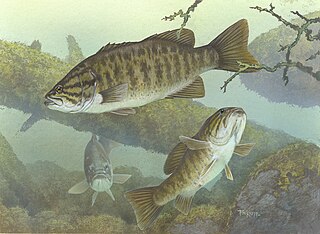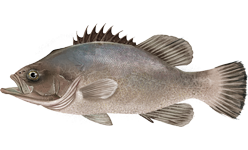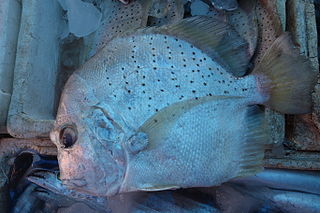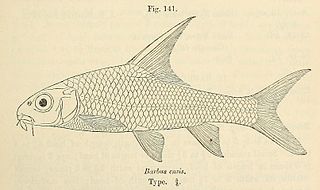
Micropterus is a genus of North American freshwater fish collectively known as the black bass, which belong to the sunfish family Centrarchidae of order Centrarchiformes. They are sometimes erroneously called "black trout", but the name trout more correctly refers to certain potamodromous members of the family Salmonidae.

The flagtails are a family (Kuhliidae) of centrarchiform ray-finned fish of the Indo-Pacific area. The family consists of about 12 species in one genus, Kuhlia. Most are euryhaline and often found in brackish water, but the genus also includes species restricted to marine or fresh water.

The shadow bass is a species of freshwater fish in the sunfish family (Centrarchidae) of order Centrarchiformes. It is endemic to southeastern United States of America.

The wreckfish are a small group of ray-finned fish in the genus Polyprion, belonging to the monotypic family Polyprionidae in the order Acropomatiformes.

Aplodactylus is a genus of marine ray-finned fishes, commonly known as marblefishes or sea carps. It is the only genus in the monogeneric family, Aplodactylidae. The fishes in this genus are found in the south eastern Indian Ocean and the southern Pacific Ocean.

Drepane is a genus of marine and brackish water ray-finned fishes, known commonly as the sicklefishes. It is the only genus in the monotypic percomorph family Drepaneidae. These fish occur in the Indian and western Pacific Oceans, and in the eastern Atlantic near Africa.

Oplegnathus is currently the sole recognized genus in the knifejaw family (Oplegnathidae) of marine centrarchiform ray-finned fishes. The largest, the Cape knifejaw, can reach a maximum length around 90 cm (35 in). Knifejaws have teeth fused into a parrot-like beak in adulthood. They feed on barnacles and mollusks, and are fished commercially. They are native to the Indian and Pacific Oceans.
Remora is a genus of remoras native to temperate to tropical marine waters worldwide.

Characodon is a genus of splitfins endemic to north–central Mexico. Two of the species are highly threatened and restricted to pools, ponds and springs in the upper San Pedro Mezquital River basin in Durango. The third species, C. garmani, was restricted to springs near Parras in Coahuila, but it became extinct when they dried out.

Dermatolepis is a genus of marine ray-finned fish, groupers from the subfamily Epinephelinae, part of the family Serranidae, which also includes the anthias and sea basses. They are found in the western Atlantic, Pacific and Indian Oceans.

Labeobarbus ensis is a species of freshwater ray-finned fish belonging to the family Cyprinidae, the carps, barbs and related fishes. This species is endemic to Angola.
Clypeobarbus pleuropholis is a species of ray-finned fish belonging to the family Cyprinidae, the family which includes the carps, barbs and related fishes. This species is found in the Chad Basin in Chad and Cameroon, as well as the Congo Basin in Democratic Republic of Congo, the Republic of Congo and the Central African Republic. This species, as Barbus kemoensis, is the type species of the genus Clypeobarbus.
Hyphalophis is a monospecific genus of marine ray-finned fish belonging to the family Ophichthidae, the snake eels. The only member of this genus is Hyphalophis devius, a species known only from its holotype which was collected in the Lesser Antilles southwest of Grenada.
Annamia is a small genus of gastromyzontid loaches native to Southeast Asia. There are two species, though one of them is of doubtful validity and identity:

Serpenticobitis, popularly known as serpent loaches, is a small genus of loaches found in the Mekong River Basin in Southeast Asia. It is the only genus in the family Serpenticobitidae.

Cycleptus is a genus of freshwater fish containing two relatively large North American species of suckers. They are endemic to river basins draining into the Gulf of Mexico, including the Mississippi, Rio Grande and others in the United States and Mexico.

Procypris is a genus of freshwater ray-finned fish belonging to the family Cyprinidae, the family which includes the carps, barbs, minnows and related fishes. The fishes in this genus are found in eastern Asia.

Schismatorhynchos is a genus of freshwater ray-finned fishes eblonging to the family Cyprinidae, the family which includes the carps, barbs, minnows and related fishes. The fishes in this genus are found on Sumatra and Borneo in Indonesia and East Malaysia.

Pseudocaranx is a genus of ray-finned fishes from the family Carangidae, the jacks, trevallies, scads, and pompanos. They occur in the western Atlantic Ocean and the Indo-Pacific.

The school bass is a species of marine ray-finned fish, it is the only member of the monotypic genus Schultzea which is part of the subfamily Serraninae which itself is classified within the family Serranidae, along with the anthias and groupers. It is found in the western central Atlantic Ocean. This species is found in deeper waters near coral reefswhere it forms small groups which feed on plankton. The school bass is a synchronous hermaphrodite. The generic name honours the American ichthyologist Leonard Peter Schultz (1901-1986) who was Curator of Fishes at the United States National Museum who examined the specimens described by Loren P. Woods (1914-1979) as Schultzea campachanus, which was later shown to be a synonym of Hildebrand's Serranus beta.
















